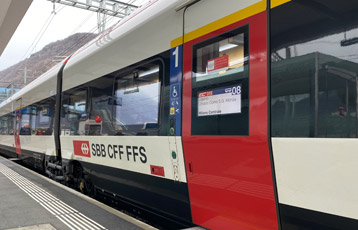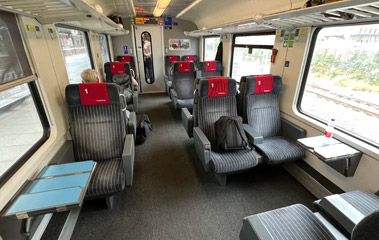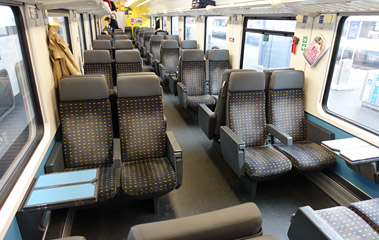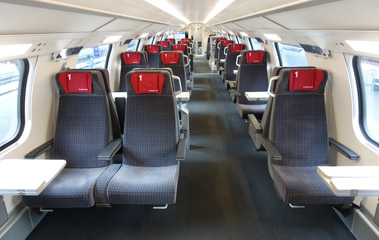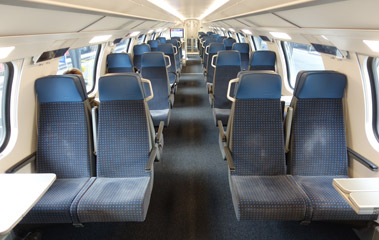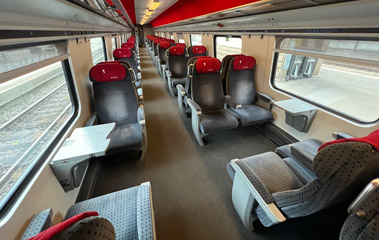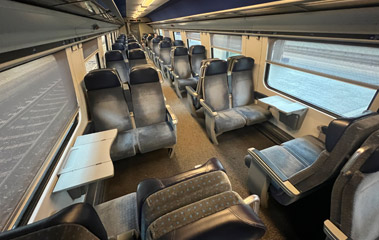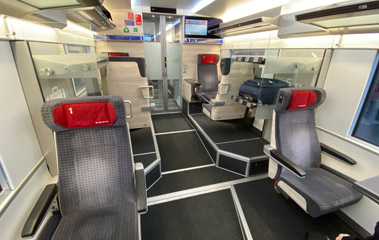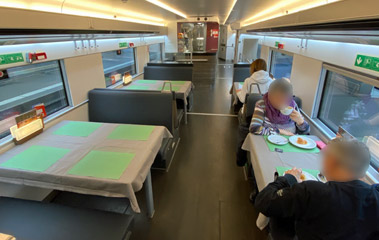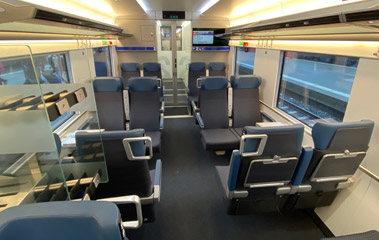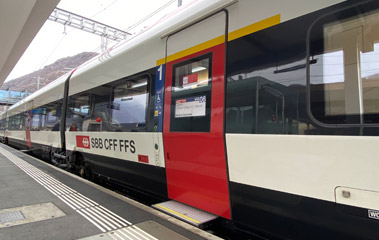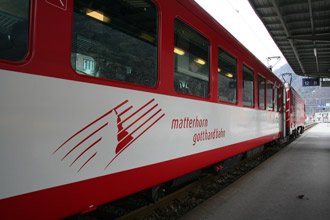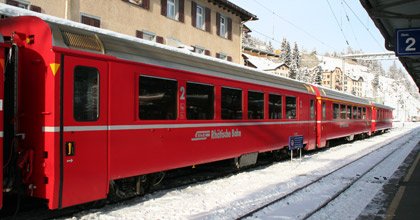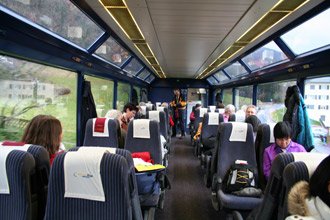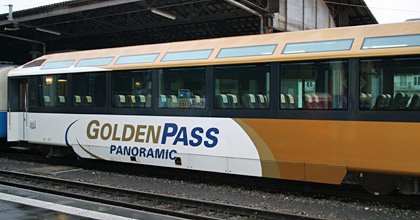|
|
|
Buy Swiss train tickets at Sbb.ch, Thetrainline.com or Omio.com |
|
|
|
Swiss tickets & passes explained
Swiss trains run like clockwork, so they say. And they pretty much do. The whole of Switzerland is covered by a frequent, punctual and efficient integrated train network that's really easy to use. In most cases you can just turn up, buy a ticket and hop on. Swiss Federal Railways (= SBB in German, CFF in French or FFS in Italian) runs most mainline trains, but there are many smaller private operators running local & regional routes.
Train travel within Switzerland
![]() How to check train times & buy tickets
How to check train times & buy tickets
![]() Standard fares,
Supersaver
fares & Saver Day Pass
Standard fares,
Supersaver
fares & Saver Day Pass
![]() Swiss Travel Passes
& Half Fare Card
Swiss Travel Passes
& Half Fare Card
![]() Map of the Swiss rail network
- download PDF
Map of the Swiss rail network
- download PDF
![]() Travel tips: Luggage, food & drink, bikes, dogs...
Travel tips: Luggage, food & drink, bikes, dogs...
![]() Useful country information:
currency, dial code...
Useful country information:
currency, dial code...
![]() Holidays, vacations & tours of Switzerland
Holidays, vacations & tours of Switzerland
Swiss scenic trains
![]() Bernina Express - The best Alpine train ride!
Bernina Express - The best Alpine train ride!
![]() Glacier Express - a great Swiss scenic
train.
Glacier Express - a great Swiss scenic
train.
![]() Golden Pass route - Montreux-Interlaken-Lucerne
Golden Pass route - Montreux-Interlaken-Lucerne
![]() Jungfraubahn - to the Top of Europe
Jungfraubahn - to the Top of Europe
International trains to/from Switzerland
![]() Train travel from the UK to Switzerland
Train travel from the UK to Switzerland
![]() Trains from other European cities to Switzerland
Trains from other European cities to Switzerland
![]() Trains from
Switzerland
to other European cities
Trains from
Switzerland
to other European cities
![]() TGV-Lyria high-speed trains Paris - Switzerland
TGV-Lyria high-speed trains Paris - Switzerland
Station guides
Other train travel information
![]() Luggage on trains &
Left
luggage at stations
Luggage on trains &
Left
luggage at stations
![]() Eurail passes &
Interrail passes
Eurail passes &
Interrail passes
![]() General European train travel
information
General European train travel
information
![]() Travel insurance,
mobile data, VPN & other
tips
Travel insurance,
mobile data, VPN & other
tips
Useful country information
How to check times & buy tickets
Do you need to book in advance?
-
No. Swiss domestic journeys don't need to be pre-booked, trains cannot 'sell out', regular full-price tickets are available in unlimited numbers, good for any train that day. For any Swiss domestic journey you can just turn up, buy a ticket at the station and hop on the next train.
-
However, you can often save money with Supersaver fares or a Saver Day Pass if you book online in advance as explained below.
-
Seat reservation is not even possible on most Swiss trains, you just turn up, buy a ticket, hop on and find any empty seat. However, it's possible to reserve a seat on some longer distance trains for a small fee if you really want to.
-
The only exceptions where seat reservation is compulsory are a handful of panoramic tourist-orientated trains such as the Bernina Express, Glacier Express or Golden Pass Panoramic trains. But regular trains on the same routes, or even in some cases regular cars attached to the same train, don't need reservation, just an open ticket.
Which website to use?
-
The following websites all link to the Swiss Federal Railways (SBB) ticketing system and can all sell regular tickets, Saver Day Passes & advance-purchase Supersaver fares. The price is the same whichever website you use.
Booking opens 6 months in advance. You print your ticket or can show it on your phone.
-
Option 1, Swiss Federal Railways, www.sbb.ch
You can check train times & fares and buy tickets for any journey in Switzerland at the Swiss Federal Railways (SBB) website www.sbb.ch.
Prices are in CHF. Be warned, the first price that www.sbb.ch shows you is usually only half the true price, because Sbb.ch assumes you have a Swiss Half Fare card as the majority of Swiss citizens do. When you change Select discount to No discount the price doubles, so be aware of this when costing your journeys. There's no booking fee.
-
Option 2, Thetrainline.com
You may find it easier to check times & buy tickets at www.thetrainline.com, in CHF, €, £ or $. It too can sell all tickets types, regular tickets, Saver Day Passes and advance-purchase Supersaver fares. Small booking fee. Who are Thetrainline.com?
-
Option 3, Omio.com
Omio.com is also easy to use, in CHF, €, £ or $. Small booking fee.
-
The SBB system not only covers SBB's own trains, it covers all Swiss public transport including private train operators and connecting ferries, buses and funicular railways. Trains run every hour or every 30 minutes, even more frequently on core routes. Trains, buses & ferries connect efficiently, and connections of even just a few minutes are reliable and easy to make.
Standard fares
-
There is one regular flexible fare between any two Swiss stations via a given route, good for any departure that day. The price is fixed and availability is unlimited, cannot sell out, you can buy at this price at the station on the day if you like. You sit anywhere you like.
-
If you buy one of these full-price full-flex tickets at www.sbb.ch, www.thetrainline.com or www.omio.com, it is valid on any train between those stations by the route stated on the date you bought it for, even if you selected a specific train.
-
A round trip costs the same as two one-ways. The return journey must be made the same day if the journey is less than 116 km. If more than 116 km the return journey may be made any day up to 10 days after the outward leg. But you may as well just buy two one-ways.
-
With a standard ticket, you can break your journey (= stop off) on the way as long as you complete the whole journey that same day.
Supersaver fares
-
For longer-distance journeys you may be offered a Supersaver advance-purchase ticket.
You can buy Supersavers a minimum of 1 day in advance and a maximum of 6 months in advance.
Supersaver fares are up to 50% cheaper than the regular flexible price. There's limited availability at each price point, the further ahead you book and the less popular the train, the cheaper it's likely to be.
Supersaver fares are only good for the specific train you book, no refunds, no changes to travel plans.
So be careful when using a train-specific Supersaver fare for an onward journey in connection with a train arriving from Paris or Milan or when arriving on a flight, unless you leave a long time buffer to absorb delay.
If you miss your train you'll have to buy a new ticket at the standard price for a later departure, but you can claim a refund of the unused Supersaver fare minus an admin fee, as long as your claim is supported by a new ticket for the exact same journey, see www.sbb.ch.
-
Using www.thetrainline.com or www.omio.com, Supersaver or Saver Day Passes will appear in the search results if they're available. Using www.sbb.ch, a black triangle with a % symbol will appear to the left of any departures in the search results which have a Supersaver fare available. Select that departure and the Supersaver price will appear during the buying process when you click Options for the outward journey. Supersaver fares can only be bought online, and only at www.sbb.ch, www.thetrainline.com or www.omio.com.
Saver Day Pass
-
For longer-distance journeys you might also be offered a Saver Day Pass if it's cheaper than a full-fare full-flex ticket.
A Saver Day Pass gives you a whole day of unlimited travel on the entire Swiss transport system, the rail equivalent of an 'all you can eat' buffet. It covers all SBB (Swiss Federal Railways) trains and most private railways, post-buses & ferries.
Saver Day Passes come in 1st & 2nd class versions, with or without Half Fare Card discount. It covers the Bernina Express & Glacier Express routes, although you need a reservation for those trains.
-
The price of a Saver Day Pass varies, you'll see a different price on each date which increases like air fares as that date approaches.
A Saver Day Pass starts at CHF 52, cheaper than a full-price ticket from Zurich to Geneva (although a Supersaver fare might be cheaper still). If you wait until the day before travel, it could cost CHF 119.
-
You can buy a Saver Day pass by running an enquiry at www.thetrainline.com or www.omio.com for a random long-distance route (for example, Zurich to Tirano), then looking for Saver Day Pass as a fare option. You can also buy at www.sbb.ch or in person at Swiss stations.
Booking opens 6 months in advance. Saver Day Passes cannot be bought on the day. No refunds, no changes after buying it.
-
The routes covered by a Saver Day Pass are shown on the official Swiss train map as solid red, yellow or black lines.
Routes shown as dotted red, yellow or black lines are not covered, this includes a few smaller private railways and some well-known tourist mountain railways such as the Jungfrau Railway & Gornergrat Railway. Unlike the Swiss Travel Passes, the Saver Day Pass doesn't get you any reduction on these dotted-line routes, if you want to use them you pay full-price.
One thing confuses people about the map: Solid lines become dashed lines where the line is in a tunnel. Dashed isn't the same as dotted!
Another way to save...
-
Save money with the Germans! Given that a normal Swiss domestic ticket from Basel to Geneva (for example) is a whopping CHF75 (€72), if there are no advance-purchase Supersaver fares available, why not just go to the German Railways website int.bahn.de and buy an advance-purchase Sparpreis ticket from the last stop in Germany to Geneva a few weeks in advance from as little as €29.99 and simply not use the Freiburg-Basel part? Freiburg (Breisgau) is the last major stop before Basel.
-
This is perfectly legitimate and saves money from Basel to most southern Swiss destinations including Geneva, Lausanne, Brig, Zermatt, Interlaken, Grindelwald, Lauterbrunnen, Tirano, St Moritz. It works in either direction. It also works from Zurich to western & southern Swiss destinations if you use int.bahn.de to book from Augsburg to Lausanne or Geneva, or from Freiburg to St Moritz or Tirano - just check that your chosen journey option passes through Zurich.
-
You need to stick to the specific trains you book. Adjust the departure time from Freiburg or Augsburg to get the time you want from Basel or Zurich southwards. If you want an early morning train from Basel or Zurich southwards, you'd simply set desired departure time from Freiburg as the previous day in the evening and use the 'enter stopover' feature to include an overnight stop in Basel or Zurich.
Swiss point-to-point fares can be expensive, so a railpass can be a sound investment. You can buy passes online from www.thetrainline.com/trains/rail-passes/swiss-travel-pass or from Switzerland Travel Centre, a Swiss Federal Railways subsidiary. But I'm often asked if a pass makes sense, or whether to go for a Half Fare card. Incidentally, the Swiss Transfer Ticket was discontinued in 2019.
A Saver Day Pass is a useful one-day all-Switzerland pass, easily bought online or at the station up to the day before see the section above.
Swiss Travel Pass
-
A Swiss Travel Pass gives unlimited travel across the Swiss travel system for a continuous period of 3 days, 4 days, 8 days or 15 days.
-
A Swiss Travel Pass Flex gives unlimited travel across the Swiss travel system for either 3, 4, 8 or 15 travel days with an overall period of a month. A Swiss Travel Pass Flex is more economical than a regular non-Flex Swiss Travel Pass if you plan to stay put between journeys. The overall one month starts on any date you like, then you can 'spend' each of your unlimited travel days on any dates you like within that period.
Check prices in CHF, USD, GBP or Euros at www.thetrainline.com/trains/rail-passes/swiss-travel-pass or www.switzerlandtravelcentre.com.
-
Is a Swiss Travel Pass cheaper than point-to-point tickets?
Swiss rail fares are expensive, so a Swiss pass can save money, depending what you plan to do and whether you're adult or youth. First check the price of the pass that suits you, then divide the price by the number of days travelling you plan to do to get the pass cost per day. Are the journeys you plan to make each day cheaper than this? If so, don't buy a pass. Or do they cost more than this? Then buy a pass! You can check fares at www.sbb.ch. It's not rocket science!
-
What does the pass cover?
See this official map of the Swiss rail network. A Swiss Travel Pass (continuous or flex) gives you unlimited free travel on all the train, bus & ferry routes shown as solid red, yellow or black lines on the map. Swiss Travel Passes give you a 50% discount (not free travel) on the routes shown as dotted red, yellow or black lines.
One thing that confuses people: A solid line becomes a dashed line when it's in a tunnel, but it's not the same as a dotted line! Routes on which you only get a discount, not free travel, notably include the Jungfrau Railway & Gornergrat railway.
-
How to buy a pass
Buy at www.switzerlandtravelcentre.com or www.thetrainline.com/trains/rail-passes/swiss-travel-pass.
Anyone from any country can buy from these sites, in CHF, £, $ or €.
-
Print your own pass or show it on your phone
You get an e-ticket/print-at-home option for Swiss Travel Passes and Swiss Travel Pass Flex, so you'll get your pass immediately with no delivery charges. You can print it out or show it on your phone.
-
Would an Interrail or Eurail pass be cheaper?
You should compare the cost of a Swiss Travel Pass with the cost of an Interrail One-Country Pass for Switzerland (if you're a European resident) or Eurail global pass (if you live outside Europe) as Interrail & Eurail passes can be significantly cheaper.
Like Swiss Travel Passes, Interrail & Eurail passes give unlimited travel on Swiss Federal Railways (SBB) and the major private train operators such as the Rhätische Bahn (RhB), Bern-Lötschberg-Simplon (BLS).
Before 2017 there were some significant private railway operators that a Swiss Pass covered but an Interrail or Eurail pass did not, but in 2017 Interrail/Eurail coverage was extended to include many more private operators, notably the Matterhorn Gotthard Bahn (MGB) which operates the line to Zermatt and half of the Glacier Express route. From 10 December 2023, the Berner Oberland Bahn joins the scheme, so Interlaken to Grindelwald, Lauterbrunnen, Wengen are now covered too.
That leaves only the post-buses, lake boats and a few minor private railways which the Swiss Travel Pass covers but an Interrail or Eurail pass doesn't. The line up the Jungfrau is not covered, but Interrail or Eurail passes give a 25% discount on normal fares.
Compare the lines covered by Interrail & Eurail on this map with the lines covered by a Swiss Travel Pass on this map. On both maps, solid lines mean covered, dotted lines mean not covered (although there may be a discount). Dashed lines simply means line in tunnel.
Swiss Half Fare card
-
Most Swiss residents have an annual half-fare card giving 50% off normal fares. Visitors can buy one lasting a month.
The discount applies to Standard fares, Supersaver fares and Saver Day Passes.
-
The 1 month Half Fare Card costs CHF 120, so (obviously) only pays for itself if you plan to clock up more than CHF 240-worth of train journeys. That's 3 full-price one-way trips between Lausanne and Zermatt, or 4 one-way trips between Basel and Interlaken, for example.
-
Again, it's not rocket science: Use www.sbb.ch, www.thetrainline.com or www.omio.com to check fares the journeys you plan to make, and halve this cost. Does this exceed CHF 120? Then buy the Half Fare Card.
-
Children 6-15 travel free with a family Half Fare card if accompanied by a parent. This is a worthwhile benefit!
-
Buy online at www.switzerlandtravelcentre.com or www.thetrainline.com/trains/rail-passes/swiss-travel-pass with prices in CHF, €, £ or $.
Classic InterCity (IC) & InterRegional (IR) trains
Double-deck InterCity & InterRegional trains
You'll find double-deck InterCity (IC) & InterRegional (IR) trains on various routes, with 1st & 2nd class sections on both upper & lower decks. Most Intercity (IC) trains also have a restaurant or cafe car. I recommend an upper deck seat for the best views - the stairs are shallow and easy, even with luggage, and there are luggage stacks both upstairs and downstairs. You'll find these double-deck trains on many IC & IR routes including Zurich-Bern-Lausanne-Geneva, Zurich-Bern-Spiez-Brig, Zurich-Lucerne, Basel-Zurich-Chur.
ICN tilting InterCity (IC) trains
These ICN Pendolino trains can tilt, enabling them to go round curves faster than normal trains. They have cut journey times on several curvaceous Swiss InterCity routes. Designed by Pininfarina, they feature a restaurant car and can reach 200km/h (125mph) although they don't often reach that speed in service. You'll find these trains operating IC trains on these routes Geneva-Basel, Geneva-Zurich, Lausanne-Basel, Lausanne-Zurich, Basel-Lucerne-Lugano-Chiasso and Zurich-Lugano-Chiasso. When using the journey planner at www.sbb.ch these trains are shown with a TT symbol in the facilities section, for Tilting Train.
Giruno Intercity (IC) & EuroCity (EC) trains
On the Basel/Zurich to Lugano route you'll find the latest Giruno trains, the international ones going through to Milan being classified EuroCity. Giruno trains have low-floor accessible entrance doors, hence the rather strange seating arrangement inside.
Swiss private operators
Swiss local trains are run by SBB or a plethora of local private operators. The trains come in all shapes & sizes, some old, some new. Below left, a local train run by Matterhorn-Gotthard Bahn (MGB) on the Brig-Zermatt line. Below right, a train from St Moritz to Chur run by the Rhätische Bahn (RhB).
Seat maps: Click here
You'll find seat numbering plans for European trains on the Train seat numbering page.
-
Maps of the European rail network: See the section on the Train travel in Europe page about rail maps.
-
Language problems
First-time visitors often think this will be a problem, but it hardly ever is. At stations, signs are usually in English as well as German, French & Italian, or they use easy-to-understand pictograms. On-train announcements on long-distance trains are often made in English.
-
First or second class?
Swiss fares are expensive, even in 2nd class. And a 1st class ticket costs 75% more than a 2nd class one. You don't get anything extra in 1st class on Swiss domestic trains - no free food or drink, no limo transfers, spa treatments or executive lounges. Just wider seats, plusher seats, more elbow room as seats are usually 2+1 across the car width instead of 2+2 as in 2nd class, fewer people per car, fewer families and loud kids, more business travellers - see the photos above. So unless it's a special occasion, or your company is paying, or you are rich, stick with 2nd class whilst within Switzerland as most travellers do.
Tip: A yellow stripe above the windows or door indicates a 1st class car on Swiss trains.
-
Luggage on trains
There are no baggage fees or weight limits, and you don't check your bags in, you simply take them with you onto the train, placing them on the racks at the end of each car, or above your head. More about luggage on European trains.
-
Left luggage at stations
Many larger Swiss stations have left-luggage lockers in various sizes, up to suitcase-sized. More information on left luggage lockers & prices.
-
Food & drink on Swiss trains
Many Swiss long-distance trains have a waiter-service restaurant car, not cheap but a real treat! A few regional trains now have vending machines selling hot drinks, cold drinks and snacks, operated with contactless bank cards.
Or feel free to bring your own food and drink (even a bottle of wine, if you like) onto the train, there's no rules against that on the rails!
-
First class lounges at stations
The lounges for first class passengers at Zurich & Geneva have been closed. More about station lounges.
-
Bicycles
You can take a bike in the luggage van on most Swiss trains if you buy a Swiss Bike Card, for more details, see the bicycles by train page.
-
Dogs & pets
In Switzerland, dogs of any size can travel for half the 2nd class fare - although for longer journeys there's a Dog Day card which can be cheaper. Small dogs up to 30cm high at the shoulder can travel free if they are in a carrier. You'll find information on the Swiss Railways website www.sbb.ch. You can easily buy Swiss tickets at the station when you get there.
For more about dogs & pets on trains in Europe, see the dogs & pets page.
Swiss scenic trains
Bernina Express: More information
Glacier Express: More information
Jungfrau Bahn: More information
Golden Pass Line: Montreux - Interlaken - Lucerne
This is a mainly narrow-gauge route from Montreux to Interlaken & Lucerne via the well-known ski resort of Gstaad. It's slower than using mainline trains, but very scenic and marketed to tourists as the Golden Pass route. Until December 2022 it involved 3 trains, but it can now be done with just two: Montreux to Interlaken and Interlaken to Lucerne. The first train is a new gauge-changing service, it runs from Montreux to Zweisimmen on the standard-gauge tracks of the Bern-Lötschberg-Simplon (BLS) Railway then from Interlaken to Lucerne on the metre-gauge Brunig Railway operated by the Zentralbahn. The new trains adjust their wheelsets at Zweisimmen. They have 1st & 2nd class panorama cars and a new luxurious Prestige class.
As with other tourist trains, reservation is necessary if you want to travel in the panoramic tourists cars, but regular trains run frequently over the same route and these need no prior reservation.
The website for the joint service is www.goldenpass.ch. But I find it easier to find Montreux-Lucerne Golden Pass times using the journey planner at www.sbb.ch - just make sure you put Zweisimmen in the via box, click advanced options and put Interlaken Ost in the second via box before running the enquiry. Then it will find journeys with 1 or 2 changes via this slower scenic Golden Pass route, rather than the faster mainline route.
Gornergrat, Matterhorn, Mt. Pilatus, Mt. Titlis, Schilthorn
If you live in the UK, you can buy excursion tickets up these mountains here: www.switzerlandtravelcentre.com
Guidebooks
Invest in a good guidebook, even in the age of the internet. For the independent traveller, I think this means either the Lonely Planet or the Rough Guide. Both guidebooks provide the same excellent level of practical information and historical background. You won't regret buying one!
Click the images to buy at Amazon.co.uk
Or buy in the USA from Amazon.com
Alternatively, you can download just the chapters or areas you need in .PDF format from the Lonely Planet Website, from around £2.99 or US$4.95 a chapter.
Holidays, vacations & tours of Switzerland
 Railbookers,
railbookers.co.uk
Railbookers,
railbookers.co.uk
Railbookers are a train travel specialist who can put together a tour or short break for you as a package, including rail travel, hotels & transfers. On their website you'll find a range of suggested tours & holidays which can be varied or customised to your own requirements. And as you're booking a package, they'll take care of you if anything happens to one part of the itinerary such as a strike or delay. They have offices in the UK, USA & Australia.
Check out their 8-day Switzerland's Lakes & Mountains tour (link to their UK site) or Swiss Lakes & Mountains tour (link to their US & Canada site) which includes both the famously scenic Glacier Express and Bernina Express trains. Also see their 5-day Classic Bernina Express & Glacier Express tour (link to their UK site) or Classic Bernina Express & Glacier Express tour (link to their US & Canada site) which also combine these two classic Alpine routes.
![]() UK call 0207 864 4600,
www.railbookers.co.uk.
UK call 0207 864 4600,
www.railbookers.co.uk.
![]() US call free 1-888-829-4775,
www.railbookers.com.
US call free 1-888-829-4775,
www.railbookers.com.
![]() Canada call free 1-855-882-2910,
www.railbookers.com.
Canada call free 1-855-882-2910,
www.railbookers.com.
![]() Australia call toll-free 1300 971 526,
www.railbookers.com.au.
Australia call toll-free 1300 971 526,
www.railbookers.com.au.
![]() New Zealand call toll-free 0800 000 554 or
see
website.
New Zealand call toll-free 0800 000 554 or
see
website.
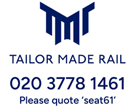 Tailor Made Rail,
tailormaderail.com
Tailor Made Rail,
tailormaderail.com
Tailor Made Rail can arrange tours of Switzerland by train including the Glacier and/or Bernina Expresses based on your own requirements, they welcome complex itineraries. As it's a package, they'll take care of you if anything happens on one part of the trip, for example, a national strike. They're TTA-protected, which is similar to ATOL's protection for air travel.
Call their dedicated seat61 phone line 020 3778 1461 and quote seat 61 when booking. From outside the UK call +44 20 3778 1461. Lines open 09:00-17:30 Monday-Friday. Their website is www.tailormaderail.com/destinations/switzerland.
 Byway,
byway.travel
Byway,
byway.travel
Byway (byway.travel) is a UK-based eco-holiday firm with a 5-star TrustPilot rating. If you're nervous about booking train travel yourself, they'll book a UK-Switzerland trip for you as a package, including hotels, starting from any British station you like. Byway includes package protection, a 100% Covid refund guarantee, free disruption & re-planning and on-demand WhatsApp support while you're away.
To see pre-configured packages from London to Switzerland, use the journey planner on their website.
Or they can build a trip to your requirements, call 0300 131 7173 (open 09:00-17:00 Monday-Friday, from outside the UK call +44 300 131 7173) or email them or use this contact form. Please say you heard about them from Seat 61.
Hotels & accommodation in Switzerland
Personal recommendations
-
In Zurich, for something special, look no further than the superb Hotel Schweizerhof, located right next to Zurich station. One of my favourite hotels, they'll even send a uniformed commissionaire to meet you at the station and carry your bags across the road.
-
In the St Moritz-Pontresina area, the Romantik Hotel Muottas Muragl is an amazing place to stay perched on the top of a mountain, with clean simple and (for Switzerland) inexpensive rooms. It's reached via the Muottas Muragl funicular railway from Punt Muragl station, between Pontresina & St Moritz.
 Backpacker hostels:
www.hostelworld.com
Backpacker hostels:
www.hostelworld.com
www.hostelworld.com: If you're on a tight budget, don't forget about backpacker hostels. Hostelworld offers online booking of cheap private rooms or dorm beds in backpacker hostels in Paris and most other European cities at rock-bottom prices.
Travel insurance & other tips
Always take out travel insurance
You should take out travel insurance with at least £1m or preferably £5m medical cover from a reliable insurer. It should cover trip cancellation and loss of cash & belongings up to a reasonable limit. These days, check you're covered for covid-19-related issues, and use an insurer whose cover isn't invalidated by well-meant but excessive Foreign Office travel advice against non-essential travel. An annual policy is usually cheapest even for just 2 or 3 trips a year, I have an annual policy with Staysure.co.uk myself. Don't expect travel insurance to bail you out of every missed connection, see the advice on missed connections here. Here are some suggested insurers, I get a little commission if you buy through these links, feedback always welcome.
![]() www.staysure.co.uk
offers enhanced Covid-19 protection and gets 4.7 out of 5 on
Trustpilot.
www.staysure.co.uk
offers enhanced Covid-19 protection and gets 4.7 out of 5 on
Trustpilot.
![]() www.columbusdirect.com is also a well-know brand.
www.columbusdirect.com is also a well-know brand.
![]() If you live in the USA try
Travel Guard USA.
If you live in the USA try
Travel Guard USA.
Get an eSIM with mobile data package
Don't rely on WiFi, download an eSIM with a European mobile data package and stay connected. Most newer mobile phones can download a virtual SIM including iPhone 11 & later, see device compatibility list. There's no need to buy a physical SIM card! Maya.net is a reliable eSIM data retailer with a 4.5 out of 5 Trustpilot rating and a range of packages including unlimited data.
Get a Curve card for foreign travel
Most banks give you a poor exchange rate then add a foreign transaction fee on top. A Curve MasterCard means no foreign transaction fees and gives you the mid-market exchange rate, at least up to a certain limit, £500 per month as I write this. The money you spend on your Curve card goes straight onto one of your existing debit or credit cards. And you can get a Curve card for free.
How it works: 1. Download the Curve app for iPhone or Android. 2. Enter your details & they'll send you a Curve MasterCard - they send to the UK and most European addresses. 3. Link your existing credit & debit cards to the app, you can link up to two cards with the free version of Curve, I link my normal debit card and my normal credit card. 4. Now use the Curve MasterCard to buy things online or in person or take cash from ATMs, exactly like a normal MasterCard. Curve does the currency conversion and puts the balance in your own currency onto whichever debit or credit card is currently selected in the Curve app. You can even change your mind about which card it goes onto, within 14 days of the transaction.
I have a Curve Blue card myself, it means I can buy a coffee on a foreign station on a card without being stung by fees and lousy exchange rates, just by tapping the Curve card on their card reader. The money goes through Curve to my normal debit card and is taken directly from my account (in fact I have the Curve card set up as payment card on Apple Pay on my iPhone, so can double-click my phone, let it do Face ID then tap the reader with the phone - even easier than getting a card out). I get a little commission if you sign up to Curve, but I recommend it here because I think it's great. See details, download the app and get a Curve card, they'll give you £5 cashback through that link.
Get a VPN for safe browsing. Why you need a VPN
When travelling you may use free public WiFi which is often insecure. A VPN encrypts your connection so it's always secure, even on unsecured WiFi. It also means you can select the geographic location of the IP address you browse with, to get around geoblocking which a surprising number of websites apply. See VPNs & why you need one explained. ExpressVPN is a best buy with a 4.7 out of 5 Trustpilot ranking which I use myself - I've signed up as an ExpressVPN affiliate, and if you go with expressvpn.com using this link you should see a special deal, 3 months free with an annual subscription. I also get some commission to help support this site.
Carry an Anker powerbank
Tickets, reservations, hotel bookings and Interrail or Eurail passes are often now held on your mobile phone. You daren't let it run out of power, and you can't always rely on the phone's internal battery or on being near a power outlet. I always carry an Anker powerbank which can recharge my phone several times over. Buy from Amazon.co.uk or buy from Amazon.com.
Touring cities? Use hill walking shoes!
One of the best things I've done is swap my normal shoes for hill-walking shoes, in my case from Scarpa. They're intended for hiking across the Pennines not wandering around Florence, but the support and cushioning for hiking works equally well when you're on your feet all day exploring foreign cities. My feet used to give out first and limit my day, now the rest of me gives up before they do!


